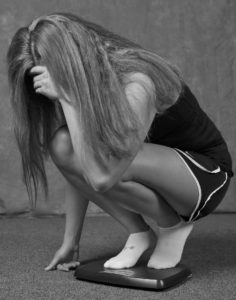- Calls to this hotline are currently being directed to Within Health or Eating Disorder Solutions
- Representatives are standing by 24/7 to help answer your questions
- All calls are confidential and HIPAA compliant
- There is no obligation or cost to call
- Eating Disorder Hope does not receive any commissions or fees dependent upon which provider you select
- Additional treatment providers are located on our directory or samhsa.gov
Dance Movement Therapy Can Connect Mind and Body
Article Contributed by Susan Kleinman, MA, BC-DMT, NCC, CEDS of The Renfrew Center
 Since human beings communicate through their bodies long before they learn to talk, the language of the body is essentially our native language. As we develop we add words to our communication, however, body language remains our most basic means of recognizing our needs and expressing ourselves (Chace with Dyrud, 1993; Kleinman & Hall, 2006).
Since human beings communicate through their bodies long before they learn to talk, the language of the body is essentially our native language. As we develop we add words to our communication, however, body language remains our most basic means of recognizing our needs and expressing ourselves (Chace with Dyrud, 1993; Kleinman & Hall, 2006).
Movement defines us from the moment we are born till the day we die. From the first kick in our mother’s womb, until our dying breath, we participate in the dance of life and experience the power of movement (Kleinman, 1993). Inherent in the dance of life, is the ability to share the emotions of others. This notion appears to be intimately linked to the functioning of mirror neurons.
According to an Italian researcher, Giacomo Rizzolatti, “Our survival depends on understanding the actions, intentions, and emotions of others. Mirror neurons allow us to grasp the minds of others not through conceptual reasoning but through direct simulation- by feeling, not by thinking (Blakeslee, 2006).”
All successful therapy involves an interaction between the mind and the body (Kleinman & Hall, 2005, 2006, Kleinman, 2009, Ressler, Kleinman & Mott, 2010). Dance/movement therapists work directly with feelings using the whole body as an empathic receptor and responder to the patient (Harris, 2008, Ressler, Kleinman & Mott, 2010, Ressler & Kleinman, 20012).
This facilitates a process that allows therapists to discover and trust their innate ability to “attend” empathically, respond authentically, and translate non-verbal experiences into cognitive insights. Dance/movement therapists are taught to hone their native language into therapeutic skills that free them to spontaneously develop on the body language and nuances of those they are working with.
 Responding to the patient’s nonverbal signals, including tone of voice, facial expressions, eye gaze, and bodily motion, can reveal the otherwise hidden shifts in states of mind and body( Kleinman, 2009, Ressler, Kleinman & Mott, 2010, Ressler & Kleinman, 2012). Resonating with these expressions of primary emotions requires that the therapist feel the feelings, not merely understand them conceptually (Siegel, p. 290, 1999.)
Responding to the patient’s nonverbal signals, including tone of voice, facial expressions, eye gaze, and bodily motion, can reveal the otherwise hidden shifts in states of mind and body( Kleinman, 2009, Ressler, Kleinman & Mott, 2010, Ressler & Kleinman, 2012). Resonating with these expressions of primary emotions requires that the therapist feel the feelings, not merely understand them conceptually (Siegel, p. 290, 1999.)
The therapist’s own experiences of embodiment, ability to access unconscious material, and way of being in the body, is part of their sense of self, and plays an important role in the relationship between therapist and patient (Kleinman, 2004, Kleinman, 2009, Ressler, Kleinman & Mott, 2010, Ressler & Kleinman, 2012).
Supporting this premise, Virginia Satir (p27, 1987) eloquently states “When I am in touch with myself, my feelings, my thoughts, with what I see and hear, I am growing toward becoming a more integrated self. I am more congruent, I am more ‘whole,’ and I am able to make greater contact with the other person.
Techniques and concepts that underlie dance/movement therapy, can be used to teach traditional therapists skills that can assist them in sharing the experience with their patients.
The artist, Gauguin said, “I close my eyes to see”. When therapists are able to “see” from the inside out, through their experiences, they are able to understand in a way that goes beyond cognitive reasoning or thinking.
A hallmark of people with eating disorders is their tendency to try to control their feelings and focus on body distortions, obsessive thoughts, and concrete, black and white thinking. As one patient explained, “It is much easier to focus on how many calories I have consumed in a day than it is to deal with day to day events such as arguments with my parents, getting good grades, or feeling accepted by others.”
Patients who suffer from trauma, as well as those who become addicted to substances, frequently possess similar patterns in their quest to stay “safe” by detaching from their bodily felt experiences.
by connecting with their feelings, is critical to their recovery. People with eating disorders have shifted their life focus to make it about food, weight and the physical body. The challenge of therapists is to shift the focus back to the more natural way of living that includes experiencing feelings.
Ignoring internal states amounts to burying feelings and the burial site exists in the body itself. Since feelings may fester underneath the body’s surface and erupt when they become intolerable, it behooves us to help our patients develop a stronger relationship with this vital part of themselves (Kleinman & Hall, 2006, Kleinman, 2009).
In order to facilitate experiences that help our patients experience and “move” their feelings, we need to not only be able to move our own feelings but to understand how to do this without losing our therapeutic balance.
Essentially, maintaining appropriate boundaries is necessary in order to balance attuning to our patients while simultaneously attuning to ourselves (Bloomgarden, Mennuti, and Cohen, 2003, p. 9-10). Gerstein, Botwin & Kleinman, 2004) state that “exquisite attunement to one’s self can permit therapists to sift through and discard feelings that indicate that they may be over-identifying with patients, while still allowing for the possibility that they may be also tapping into the patient’s issues in an embodied, less conscious, fashion” (p, 13).
For example:

“Marsha was concerned about mysterious feelings and sensations that were causing her to feel “out of control”. As she moved between two chairs to reach the chair she would sit in, she suddenly froze and her back leg became paralyzed. She was unable to move in any direction. Her back leg was so tense that her whole body began to shake. I tried to ground her and help her remain calm.
Although she looked very frightened, I wanted her to regain her composure, if possible, so I moved closer to her, established direct eye contact and stretched out my hand. She took it and together we began a kind of “dance”, moving forward, backward, sideways, breathing together in a shared rhythm.
Although I seemed to be guiding her, I was actually being guided by both her overt and very subtle movements, as well as the very direct eye contact we maintained. I used my voice to softly remind her that she would be ok.
After a few minutes, I felt a slight shift as she loosened her grip on my hand, moving out of the space that had been like “quicksand”. She breathed more deeply and sat in the chair to rest. She was aware that it was “something psychological” that affected her physically in such a way that she became paralyzed. When I’d moved with her, she said, she’d instantly felt safer because she wasn’t alone” (Kleinman & Hall, 2006).
Techniques that emanate from concepts underlying dance/movement therapy, emphasizing one’s inner experience, allow therapists to use their own feeling states to understand on a body level what their patients are experiencing. These concepts include rhythmic synchrony, kinesthetic awareness, and kinesthetic empathy.
- Rhythmic Synchrony personifies the ability to be in tune with, and cultivate relationship and connection between ourselves and our patients (Kleinman & Hall, 2006, Ressler Kleinman & Mott, 2010, Ressler & Kleinman, 2012). This could occur by walking with the patient, breathing in the same rhythm, or even speaking at a pace that duplicates their rhythm. When therapists are not in rhythm with their patients, they may try to progress too fast, request too much information, or speak too quickly. This could trigger patients to need to detach if they become overwhelmed.
- Kinesthetic Awareness is the therapist’s ability to sense herself / himself physically on both an internal and an external level( Kleinman & Hall, 2006, Ressler, Kleinman & Mott, 2010, Ressler & Kleinman, 2012). For example, a therapist might ask their patient a question and simultaneously, focus on their own inner feeling states. When therapists rely on the language of the ”cognitive mind” only, and are detached from listening to their body, their interventions may reflect their lack of connection to themselves. Therefore, it is likely that their patients will respond with the same degree of detachment.
- Kinesthetic Empathy represents the ability of therapists to foster shared expression. (Berger,1956, Kleinman & Hall, 2006, Kleinman, 2009, Ressler, Kleinman & Mott, 2010, Ressler & Kleinman, 2012). Their responses could include conscious awareness of their own sense of the patient based on the feelings they experience. This is clearly seen in the example involving Marsha (see above). Pallaro (2007) says that “the recent discovery of mirror neurons may indicate that the ability to respond to another’s feelings states and understand them is, in fact, a result of bodily based kinesthetic empathy” (p.183).
Techniques emphasizing these concepts challenge therapists to expand their own boundaries, without losing their therapeutic balance, in order to think with their body as well as their mind. When therapists hone these skills, they can pass them onto their patients.
Focusing on accessing the language of the body, and facilitating expression of feelings and thoughts that underlie the presented problems, is critical to challenging patients with eating disorders to explore how they feel living in their bodies, a central ingredient for genuine change, This, in turn, affects how they live their lives, the real sign that recovery has occurred and that the patient is on a pathway into fuller, more meaningful and productive life experiences. (Ressler & Kleinman, 2006).
In contrast, when we try to be in control, we initiate planned, forced actions and interventions causing us to feel tense, burdened, and alienated from our ability to trust ourselves. Likewise, those we are attempting to reach may also sense the strain, and respond accordingly.
However, when we allow ourselves to be in charge, we yield to our authentic life forces, creating a natural flow from within that is empowering. Therefore, it is critical that we, as therapists, take the lead to help our patients trust themselves to discover their own natural flow.
One patient, Mary, explained how these skills were important to her in terms of being in charge versus being in control.
“When we are in control, we don’t allow life to just happen. Being in control means that we spend so much of our energy and so much of our time trying to attain perfection in every sense of the word that we miss out on day-to-day life. We miss out on everyday simple things.

We miss out on the happy, magical, mysterious things. The unfortunate thing is attempting to be in control usually leads to more things being out of control. Life then becomes stressful, and all of our attention becomes focused on controlling the stress in our lives. Giving up control, little by little, will lead to much happier, healthier, beautiful lives.
I want to eventually be able to feel as if I don’t need to be in control of everything. I want to be in a place where I am okay with allowing life to happen as it should. I want to enjoy the everyday moments.
Being in charge allows our lives to be care-free, yet not care-less. Not chaotic. We are able to trust our instincts and trust our feelings, and this leads to feelings of confidence. When you are confident, you understand how vital being in charge really is, and that in turn leads to even stronger self-confidence.
When you are in charge, you trust your authentic, true self. You know that your true self is okay and you know that you can trust that inner part of you in every aspect of your life. How wonderful that must feel. That is something I strive for – to be able to trust myself enough to want to be in charge.”
In summary, using our whole self is, in essence, our greatest therapeutic tool. Experiential understanding begets cognitive understanding and connecting with feelings can be translated into insightful cognitions.
There is always communication present. When therapists can connect with and utilize their own feelings as part of the therapeutic process, they can help their patients decode their own inner experiences and transform them into opportunities for growth.
References
Berger, M.R. (1956). Bodily expression of experience and emotion. In J. Fried, S. Katz, S. Kleinman, J. Naess , (Eds.). (1989). A collection of early writings: Toward a body of knowledge. Vol. 1. Columbia , MD. American Dance Therapy Association
Blakeslee, S. ( 2006). Cells That Read Minds. Published: January 10, 2006. Retrieved May, 2008 from http://www.nytimes.com/2006/01/10/science/10mirr.html?_r=1&oref=slogin
Bloomgarden, A., Mennuti, R., & Cohen, E. (2003).Therapist self-disclosure: Implications for the therapeutic connection. The Renfrew Center Working Papers. Volume 1, Fall (p. 9-10). Philadelphia, PA.
Chace, M. with Dyrud, J. (1993). Movement and Personality. In S. Sandel, S. Chaiklin, & A. Lohn (Eds.), Foundations of dance/movement therapy: The life and work of Marian Chace. (pp. 252-255). Columbia, MD: The Marian Chace Memorial Fund of the American Dance Therapy Association.
Gerstein, F., Botwin, S. & Kleinman, S. (2004). Developing connections in group therapy. The Renfrew Center Working Papers. Volume 2, Fall (p. 13). Philadelphia, PA.
Harris, R. (April, 2008) personal communication
Kleinman, S. & Hall, T. (2006). Dance/Movement therapy: A method for embodying emotions. In Davis, W & Kleinman S (ED) The Renfrew Center Foundation Healing Through Relationship Series: Contributions to Eating Disorder Theory and Treatment Volume 1: Fostering Body-Mind Integration. Philadelphia, PA (pp 2-19).
Kleinman, S. (2004). Use of self as a dance/movement therapist: Our greatest therapeutic tool. Proceedings of the American Dance Therapy Association 39th Annual Conference.Columbia, Maryland: American Dance Therapy Association.
Kleinman, S & Hall, T. (2005). Dance movement therapy with women with eating disorders. In F. Levy (Ed.) Dance/movement therapy, A healing art. Revised Edition (p. 221-227). Reston, VA: The American Alliance for Health, Physical Education, Recreation, and Dance.
and Consumers, Part 3 of 3, (pp. 70-74). Serial 103-91, US Government Printing Office, Washington, 1994.
Kleinman, S. (February, 1994). Submission for the Record, Statement of The American Dance Therapy Association to the Sub-committee on Ways and Means, House of Representatives Hearing on The Congressional Budget Office’s Analysis of the President’s Health Care Reform Proposal, Volume X11, President’s Health Care Reform Proposals: Impact on Providers
Kleinman, S. (2009). Becoming whole again: Dance/Movement therapy for those who suffer from eating disorders. In S. Chaiklin & H. Wengrower (Eds.), The art and science of dance/movement therapy: Life is dance (pp. 125-144). New York, NY. and Hove E. Sussex: Routledge
Pallaro, P. (2007). Somatic countertransference: The therapist in relationship. Authentic Movement: Moving the body, moving the self, being moved (pp. 176-193). London: Jessica Kingsley.
Ressler, A. and Kleinman, S. (2006). Reframing Body-Image Identity in the Treatment of Eating Disorders. In W. Davis & S. Kleinman ( Eds). The RenfrewCenter Foundation Healing Through Relationship Series: Contributions to Eating Disorder Theory and Treatment Volume 1, Fostering Body-Mind Integration. Philadelphia, PA,
Ressler, A and Kleinman, S. Experiential and Somatopsychic Approaches to Body Image Change. In: Thomas F Cash, editor. Encyclopedia of Body Image and Human Appearance, Vol 1. San Diego: Academic Press; 2012. p.p. 418-424.
Ressler, A., Kleinman, S, A, Mott, E, (2010). The Use of Holistic Methods to Integrate the Shattered Self. In Maine, M., Hartman McGilley, B., Bunnell, D ( Eds), Treatment of Eating Disorders : Bridging the research-practice gap ( Ed) . Academic press Publications.
Satir, V. (1987). The therapist story. In M. Baldwin & V. Satir (Eds.), The use of self in therapy (p. 23). New York: The Haworth Press.
Siegel, D. J. (1999).The developing mind (p. 290). New York: The Guilford Press.
Susan Kleinman, BC-DMT, NCC, CEDS, dance/movement therapist at The Renfrew Center of Florida, is a trustee of the Marian Chace Foundation, past president of the American Dance Therapy Association and past chair of The National Coalition for Creative Arts Therapies. She is co-editor of The Renfrew Center Foundation’s Healing through Relationship CD, co-author of chapters on body/mind methods in the textbook Bridging the Research-Practice Gap in the Treatment of Eating Disorders and the first Encyclopedia of Body Image and Human Appearance.
She has also contributed several chapters for textbooks used in the education and training of dance/movement therapists, has earned international recognition for her expertise in using dance/movement therapy as a treatment method for women with eating disorders and is a recipient of the American Dance Therapy Association’s 2009 Outstanding Achievement award. Her work is featured in the documentary on eating disorders entitled Expressing Disorder: Journey to Recovery.
Published Date: June 14, 2013
Last Updated & Reviewed By: Jacquelyn Ekern, MS, LPC on August 2, 2017
Published on AddictionHope.com, Online Information on Eating Disorders
